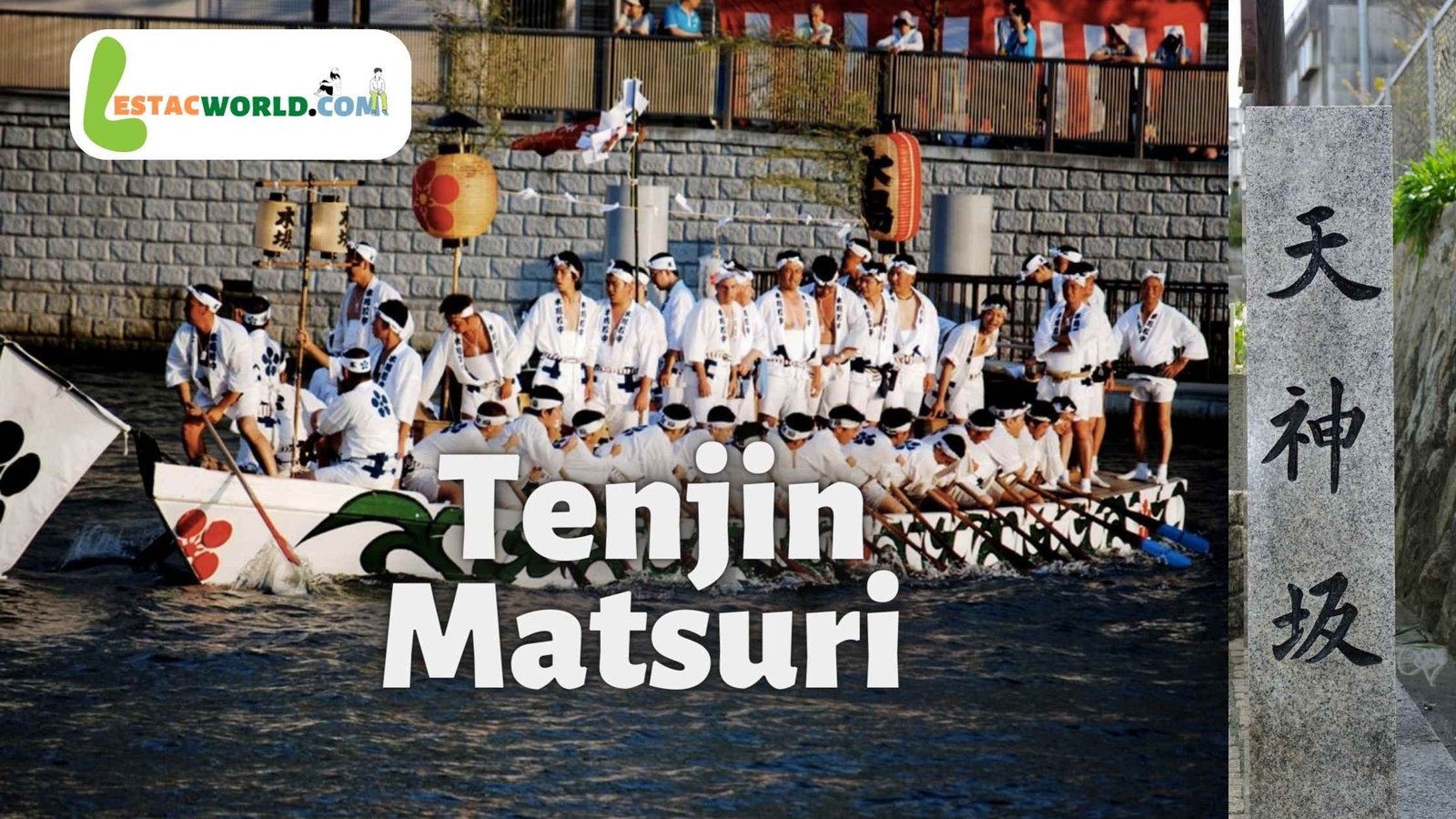About Tenjin Matsuri festival in Japan
Tenjin Matsuri is a traditional Japanese festival held every year in Osaka to honour Sugawara no Michizane, the god of learning and the arts. Every year on July 24 and 25, the festival takes place. It is one of the most important events in the city and draws millions of people from all over the world.
The festival has been going on for more than a thousand years. It is known for its lively atmosphere and amazing fireworks shows. In the morning, there is a ceremony to clean the area. In the evening, there is a parade of portable shrines (mikoshi) and a parade of traditional Japanese floats (hoko).
The highlight of the festival is a river procession on the second day, when over 100 boats with lanterns, musicians, and dancers travel along the Okawa River. At the end of the festival, there is a spectacular fireworks show that lights up the night sky over Osaka.
Tenjin Matsuri is a festival that honours Japanese culture and traditions. It is also a time for people to get together with their families and friends to enjoy the festivities. It’s a one-of-a-kind and unforgettable experience for anyone who visits Japan in the summer.
Facts about Tenjin Matsuri festival in Japan
Here are some interesting facts about the Tenjin Matsuri festival in Japan:
- Tenjin Matsuri is one of the three largest festivals in Japan, along with Kyoto’s Gion Matsuri and Tokyo’s Kanda Matsuri.
- The festival is held annually on July 24th and 25th, and is one of the oldest continuous festivals in Japan, dating back over 1,000 years.
- The festival honors Sugawara no Michizane, a scholar and politician who was deified after his death as Tenjin, the god of scholarship and learning.
- The festival features a procession of portable shrines (mikoshi) and traditional Japanese floats (hoko), as well as a spectacular fireworks display over the Okawa River.
- One of the highlights of the festival is the river procession, where over 100 boats decorated with lanterns and carrying musicians and dancers travel along the Okawa River.
- Tenjin Matsuri is not only a celebration of Japanese culture and tradition, but also a time for people to come together and enjoy the festivities with their families and friends.
- The festival attracts millions of visitors from around the world every year, and is an excellent opportunity for tourists to experience Japanese culture and traditions.
- Tenjin Matsuri has been designated an Important Intangible Folk Cultural Property by the Japanese government, recognizing its cultural significance and historical importance.
- The festival is held at the Osaka Temmangu Shrine, which was moved from Kyoto to Osaka in the 16th century by the warlord Oda Nobunaga.
- In addition to the traditional festivities, Tenjin Matsuri also features modern attractions such as food stalls, live music, and carnival games.
History time line of Tenjin Matsuri festival
The history of Tenjin Matsuri festival dates back over a thousand years, and here is a timeline of some of the significant events and changes that have occurred over time:
951 CE: Sugawara no Michizane, a scholar and politician of the Heian period, dies in exile. After his death, many calamities occur in Kyoto, which were attributed to his vengeful spirit.
- 964 CE: In response to the calamities, a Shinto shrine was established in Kyoto, where Michizane’s spirit was enshrined and worshipped as Tenjin, the god of scholarship and learning.
- 994 CE: The Tenjin Matsuri festival was first held in Kyoto, to honor Tenjin and pray for his blessings on scholarship and the arts.
- 1571 CE: Oda Nobunaga, a powerful feudal lord, ordered the transfer of the Tenjin Shrine to its present location in Osaka.
- 1810 CE: The festival was expanded to a two-day event, with the addition of a river procession on the second day.
- 1829 CE: The festival was suspended due to the Great Tenmei Famine, which devastated Japan and caused widespread famine and disease.
- 1868 CE: The Meiji Restoration brought about significant political and social changes in Japan, including the separation of Shinto and Buddhism and the establishment of religious freedom. As a result, the Tenjin Shrine was renamed the Osaka Temmangu Shrine and became a purely Shinto shrine.
- 1903 CE: The festival was canceled due to an outbreak of cholera in Osaka.
- 1912 CE: The festival was revived after a hiatus of several years, and has been held annually since then, except for a few years during World War II.
- 1955 CE: The river procession was suspended due to pollution in the Okawa River, but was later resumed in a modified form.
- 1984 CE: The festival was designated an Important Intangible Folk Cultural Property by the Japanese government, recognizing its cultural significance and historical importance.
What is the impact of Tenjin Matsuri festival on Osaka city
The Tenjin Matsuri festival has a significant impact on Osaka city, both culturally and economically. Here are some of the ways in which the festival affects the city:
- Cultural impact: The festival is an essential part of Osaka’s cultural heritage and attracts millions of visitors from around the world every year. It is a time for people to come together and celebrate their traditions, and to honor Sugawara no Michizane, the god of scholarship and learning.
- Tourism: The festival is a significant tourist attraction and generates significant revenue for Osaka’s economy. According to the Osaka Convention & Tourism Bureau, the festival attracts more than 1.3 million visitors every year, generating an estimated economic impact of over 10 billion yen (approximately 95 million USD).
- Business opportunities: The festival provides significant business opportunities for local vendors, including food stalls, souvenir shops, and other businesses that cater to tourists and festival-goers.
- Infrastructure: The festival requires significant infrastructure support from the city, including transportation, security, and sanitation. This infrastructure investment not only benefits the festival but also improves the city’s overall infrastructure for residents and tourists.
- Community engagement: The festival is an opportunity for local residents to engage with their community and participate in traditional cultural activities. Many residents of Osaka are actively involved in the planning and execution of the festival, volunteering their time and resources to ensure its success.
Overall, the Tenjin Matsuri festival is an essential event for Osaka city, both culturally and economically. It is a time for residents and visitors alike to come together and celebrate their traditions and enjoy the festive atmosphere of the city.
Statistics of Tenjin Matsuri festival in Japan
Here are some statistics and facts about the Tenjin Matsuri festival in Japan:
- Tenjin Matsuri is one of the three largest festivals in Japan, along with the Gion Matsuri in Kyoto and the Kanda Matsuri in Tokyo.
- The festival has a history of over 1,000 years and is held annually on July 24th and 25th in Osaka.
- The festival attracts over 1.3 million visitors each year, making it one of the biggest festivals in Japan in terms of attendance.
- The festival is known for its boat procession on the Okawa River, which features illuminated boats decorated with lanterns and traditional Japanese designs.
- The festival also includes a land procession, in which a portable shrine (mikoshi) is carried through the streets of Osaka.
- The festival is held in honor of the deity of learning, Sugawara no Michizane, who is believed to protect scholars and students.
- In addition to the boat and land processions, the festival features a variety of other traditional events, including taiko drumming, dance performances, and a fireworks display.
- The festival is a major cultural event in Osaka and is celebrated by both locals and tourists alike. It is a time for people to come together to celebrate their community and their heritage.
What are do's and Dont's at Tenjin Matsuri festival in Japan
Tenjin Matsuri is one of the three largest festivals in Japan, held in Osaka every year on July 24th and 25th to honor the deity of learning, Sugawara no Michizane. Here are some do’s and don’ts to keep in mind when attending the Tenjin Matsuri festival:
Do’s:
- Wear comfortable clothing and footwear, as you will be walking around a lot.
- Try the local festival food, such as takoyaki (octopus balls), yakisoba (fried noodles), and okonomiyaki (Japanese pancake).
- Take part in the traditional events of the festival, such as the boat procession on the river and the mikoshi (portable shrine) parade.
- Respect the customs and traditions of the festival and the local community, such as not littering or smoking in non-designated areas.
- Bring a camera to capture the vibrant and colorful sights of the festival.
Don’ts:
- Do not touch or move any of the festival floats, boats, or decorations, as they are considered sacred and should be left undisturbed.
- Do not engage in rowdy or disruptive behavior, as it is considered disrespectful to the local community and can spoil the festive atmosphere.
- Do not block the parade route or impede the progress of the mikoshi, as it can cause safety concerns and disrupt the flow of the festival.
- Do not take photographs or videos of people without their permission, especially of geisha or other performers who may be sensitive to being photographed.
- Do not bring large bags or backpacks that may cause inconvenience or safety concerns for other festival-goers.



Comment (0)